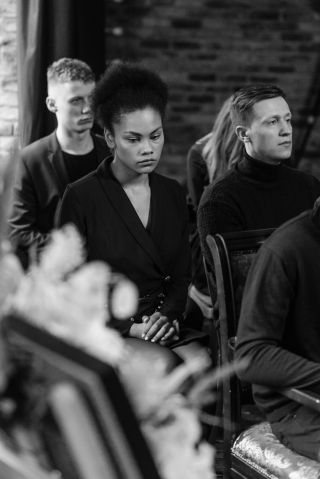Social Networking
The Power of Super Weak Ties
Here’s how we are influenced by relationships we barely notice.
Posted May 17, 2024 Reviewed by Davia Sills
Key points
- The strength of a relationship is often determined by the distance of the other person to oneself.
- However, even weaker than weak relationship ties can serve an important function.
- People have a lot to learn behaviorally from others, even those they don't know well or at all.

Why are super-weak relationships so important to us? They give us behavioral confidence in everyday life, and they play a role in the formation of a common culture that everyone can perceive.
Strength of relationship ties
We deal with the strength of relationship ties every day. The strength or closeness of relationships is shown in expressions about how closely or distantly related we are to someone. From the closeness of the relationship, we can derive the duties of those who are associated with each other. Even when we talk about friends or best friends, we make a distinction between them.
In the past, people tried to measure relationships according to their strength or distance (von Wiese 1924; Granovetter 1982). Meaning was determined by the closeness or distance of the other person to oneself. Relationship strengths are essential in social network research. There, strength has something to do with influence but also with mutual support, intimacy, the time spent together, and the emotions at play.
The discovery of weak relationships
When Granovetter wrote his famous paper on the strength of weak relationships in 1982, it was still a sensation that this type of relationship should also be particularly significant. The special thing about it is the range of acquaintances who are referred to as weak relationship partners and whom we only meet occasionally. However, these are particularly important when it comes to disseminating or passing on information. Suitable jobs, for example, tend not to be found among close friends but rather by asking acquaintances. It is probably very similar when it comes to finding accommodation, which is often very difficult in larger cities.
Even weaker than weak relationships can influence our behavior
I have now added another type of relationship strength to these two in my new book about super-weak ties. These are relationships that are weaker than weak. These are not relationships in the usual sense. Rather, in situations where people we don't know are present, we constantly observe other people and base our behavior on them. This works particularly well when we find ourselves in an unfamiliar, less familiar situation. It also works in unpleasant situations.
Example: A funeral with many mourners
Let's imagine that someone with many friends in our circle of acquaintances has died, and we are attending their funeral. We only know a few of the other attendees personally. On the one hand, we are grieving, and on the other, we are not quite sure how we should behave towards the widow or widower. How to offer reverent condolences and who we need to take into account.
So, it's a good thing that other mourners have arrived shortly before us. We don't need to know them to be able to copy their behavior. We join the queue and do the same. By copying their behavior, we gain confidence. As everyone looks at each other, not everyone condoles differently, but uniformity develops.

How you behave is something you learn from others
People who have more experience of how to behave in this situation are much more confident than those who, fortunately, have only rarely had to attend a funeral service. However, public mourning and the course of a funeral ceremony are of particular concern to all participants. Therefore, masters of ceremonies often guide us through such rather awkward situations, rather like professionals who tell the unsure participants what to do next. Professionals can be funeral orators or pastors for the sad situation described. It is up to them and the more experienced ones to guide the others through their actions.
These are often people with whom we have no relationship in the previous sense. Nevertheless, the visual relationship in the case described is of great importance for our behavior. So, if we wanted to describe such a relationship, we would have to characterize it as a super-weak relationship. It is clearly below an acquaintance.
Often, you're not alone among strangers.
However, given the event described, we should know some other people better, i.e., have strong relationships with them. It is also likely that acquaintances, i.e., people with whom we have a weak relationship, will also be present. A mixture of different relationship strengths in such an event is not unusual. It often happens. This allows us to talk to others about the event and the other people present. The behavior of the other people can be classified together once again through this second level of relationships.
Culture is created through mutual adaptation.
Because many of those present take their cue from those with particular experience, a kind of uniformity of behavior emerges. This now resembles the behavior that those with experience have already become familiar with at similar events. It can be seen as a kind of chain of events. One orients oneself to the previous event. In other words, it is a mechanism that ensures that the funeral service of the example is similar to those that have already taken place in the past.
The result is something like continuity. The continuity of behavior—of the forms in which such a ceremony takes place—is an expression of the culture in this domain. The mutual orientation, therefore, serves another function: It creates a uniformity of culture that is stabilized by the chain of experiences of the participants and the copying of behavior.
Why the adaptation sometimes doesn't work
However, adopting behavior does not always work as easily as it does with the great uncertainty in a grief event. Sometimes, the behavior of others is not compatible with one's own culture or worldview. In this case, the orientation towards others does not work either. The rule described is, therefore, tied to certain conditions, which are sometimes more or less realized depending on the type of situation and the distance of the onlookers.
You can find more on this topic in my book, Super Weak Ties: What Culturally Holds Our Society Together.
Facebook image: oneinchpunch/Shutterstock
References
Granovetter, Mark S. (1973): The Strength of Weak Ties. In American Journal of Sociology 78, pp. 1360–1380.
Stegbauer, Christian (2024): Super Weak Ties. What Culturally Holds Our Society Together. 2024. Wiesbaden: Springer.
Wiese, Leopold von (1933): System der allgemeinen Soziologie als Lehre von den sozialen Prozessen und den sozialen Gebilden der Menschen (Beziehungslehre). 2., neubearb. Aufl. München: Duncker & Humblot.




